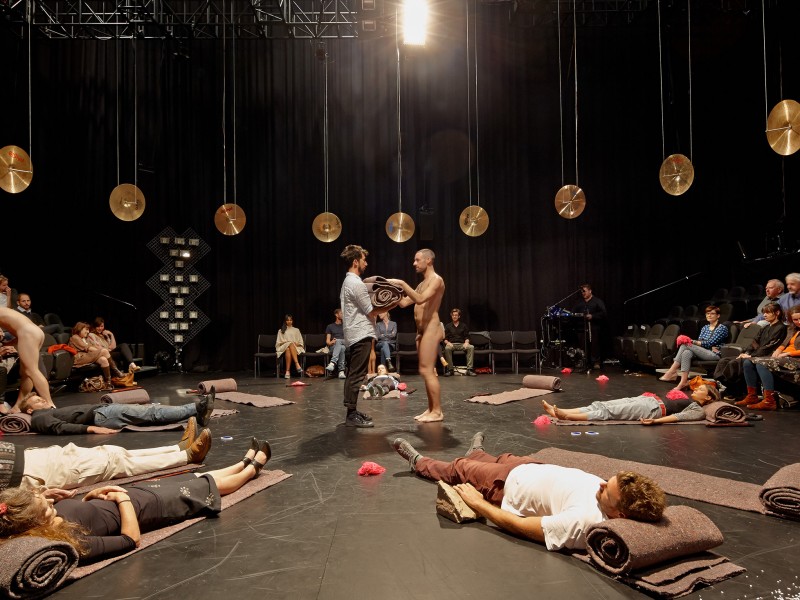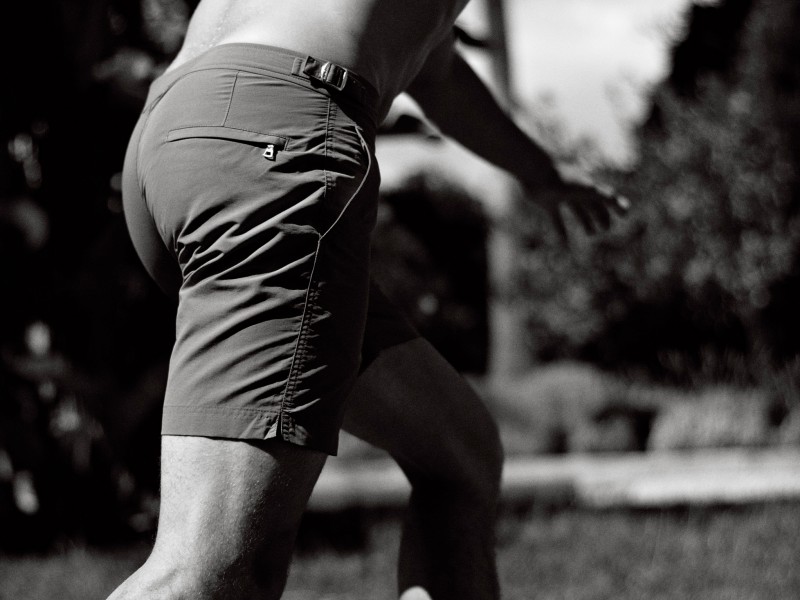Susan Dimasi established luxury fashion house Materialbyproduct (MBP) in 2004 as a means to invent future systems for fashion design. These systems are shaped by the Australian context, as well as the fashion industry’s needs for smaller production runs within less physical space. She has refined her craft with the simplest of tools—her own two hands and her active mind over an extended period of contemplation, training, trial, reinvention and review. The byproducts of her system are garments within her Artisan collection which she sells to her influential clients. Soon Dimasi will introduce a diffusion line titled Production and has contracted Ryan Euinton as designer and technical director to develop the translation.
In October 2012, Susan Dimasi, Ryan Euinton and National Gallery of Victoria (NGV) curator Paola Di Trocchio met to study three garments at the NGV. These garments recorded technological innovations in garment construction over three centuries and have informed the invention and influence of MBP. The 18th century open robe and petticoat selected by Dimasi recorded the technological inventions derived from the quest for beauty in its rich textile. The soft pastel bodice and skirt by Chloé from the 1970s interpreted the 18th century floral motif through twentieth century modes of mechanical reproduction with both beauty and compromise, while the 1996 Martin Margiela dress reinvented elaborate handmade clothing through the photographic image. In the fashion and textiles viewing room Dimasi, Euinton and Di Trocchio discussed these three pieces and how Production will continue the dialogue of future invention.
Paola Di Trocchio: Are the garments as you remember them?
Susan Dimasi: They are like old friends. I hope my garments are like old friends. I always prefer when people tell me that they have lived with one of my pieces and it’s been part of their life’s journey.
PD: But they have also been part of your life’s journey in a way because you met them whilst you were working here at the NGV.
SD: Yes, working here at the NGV was my quiet internship that I had with many European design houses through the ages. So it’s actually quite moving to be back. What I loved so much about spending time with these pieces and why I wanted Ryan to see them is because they talk to you from the inside out. Through spending many many hours in the quiet space of storage I felt like I could travel back in time and re-engage in a set of decisions that have been made to come to this outcome. Some are decisions I agreed with and others I didn’t agree with. Some were logical and process driven and some were illogical.
PD: So did you choose these pieces to show Ryan because you felt they were logical?
SD: Not necessarily. I think a successful piece has both logic and emotion. It’s not purely one or the other. Take this exquisite 18th century gown for example, the logic behind creating these amazing jacquard fabrics was finding a mechanical way to embroider. So the jacquard loom was invented. It was considered the first computer, so there was a logic. But it was also expensive and time consuming. So why? For beauty. The drive is completely poetic. The drive is one for beauty. The outcomes are extraordinary. But the drive was for beauty not for the first computer so that’s in a way illogical. I find myself often in the same quandary. This is where Ryan comes in. Currently I have this concept of wanting to scan my garment half way through the artisan process to create something which is less hands-on and more mechanised. But our initial interventions are revealing that it’s not necessarily going to be hands-free and non-emotional, but rather a highly emotional way of approaching the idea of scaling production.
PD: Designers often create diffusion lines with economic motivations, but from what I know about Production I’m wondering if that’s actually part of it?
SD: Production is not supposed to just be a cheaper version of what I do as an artisan. It still has to have poetry, integrity and beauty and has to be a really fulfilling experience. I talk about it as a diffusion line as a way to position it in the fashion landscape, but the word diffusion suggests that you are diluting what you do here in the ivory tower, whereas that’s never been my view. The diffusion line has to be an altered experience, but still a legitimate experience. It’s about reaching the most people to achieve real cultural change. That’s important to me. Just looking across these garments helps to explain it. Life in this 18th century dress would be a very different life to life in that 1970s Chloe or that 1990s Margiela. In the 18th century dress you needed someone to dress you, so the way you physically felt, emotionally felt, the way you moved through life and inhabited the world, where you went, how you got there and your experience of life was utterly different.
PD: So how will all these processes of invention inform Production?
SD: Ryan and I have been having a conversation about how to digitise and mechanise what I do as an artisan. The aspiration is to make a hands-free garment.
RYAN EUINTON: I think the reason why Sue brought me into the house is that I spent five or six years with Materialbyproduct and then some time outside working in a much different production environment. So to me it was actually quite a simple and a logical marriage. Having been in the MBP world and then out of it, how do I come back into it?
SD: I know that people have found it disconcerting when I’ve said I’m going to bring a designer into Production, because in the “cult of the genius” designer it would stand to reason that I’m supposed to pretend that I design everything. But Ryan’s not going to go away and draw a bunch of dresses and come back to me and say, what do you think? Ryan will be engaged in the process alongside of me and his role is to translate that artisan process into a digital, mechanical means of production. It’s a highly technical role, as much as it is a creative responsibility and the axis that Materialbyproduct has always pivoted on, is that technique and creativity are not separate things.
RE: In Susan’s work there are inherencies that we can’t discard. There are so many different aspects to the product that it’s actually impossible to send something off to a factory and have it produced. It’s not physically possible.
SD: I think this Margiela piece is brilliant. Margiela takes a 1920s sequin dress, photographs it, prints it out and reproduces it in multiples. So like Duchamp, he’s playing with the tension between the original and the reproduction. But he does it in the 1990s which is deeply seeded in grunge culture. In a culture of jeans and t-shirts he produces the dress like a t-shirt, which is a masterstroke. This relates strongly and philosophically to what I do in MBP in that it’s recycling. He’s recycling a sequin dress in an intellectual, funny and poetic way. His sense of humour is in the grey panels. The 2D photograph does not wrap around the side of the body, so Margiela fills in the negative spaces with grey panels which I think is brilliant.
RE: Would you also say it’s an honesty?
SD: Yes, and it’s a bit blunt. By the time we get to this point in culture, we consume images which are 2D but the fact is our bodies are still 3D and I love the way he highlights that here. We are still physical entities and this grey space to me acknowledges that we can’t get away from that.
PD: So will Production influence Artisan?
SD: Production will have a conversation with Artisan. It is looking to intervene and document essential data from Artisan and extrude it in a new way. We’re taking an Artisan garment when it’s still flat and we’re scanning it with the view of then printing it out and machine embroidering the prints together to create a garment. It’s a homage to this Margiela in a way.
RE: In some ways it is the idea of the facsimile, but it also has to do more than that because it has to fit and accommodate sizing ranges. The points where the scans are joined through mechanical embroidery will become our sizing ranges.
SD: That machine embroidery is really what relates to the Chloé here. While this Chloé is machine embroidered, it’s also very delicate. The key difference between this 18th century gown and the Chloé is that the Chloé cuts through flowers. That’s an economic decision. The difference between Artisan and Production is in cutting through the flowers. You never cut through flowers in couture. It’s a sin. There is also a sense of the hand in the application of the hooks and eyes in this garment. This is not considered economically appropriate for reproduction. This is a particular area of development for Ryan and I because at the artisanal level I still put on all my hooks and eyes by hand and it’s very time consuming. Whether you put three hooks and eyes on or five really impacts the final price.
PD: But it also impacts the way that it sits on the body. It’s either held properly or there’s a slight compromise.
SD: This is why I was talking about this Margiela garment. It’s like a t-shirt. There are no fastenings on it. You literally just pull it over the head. From an execution point of view, the construction of it is dead simple. From a wearability point of view, it’s dead simple. But as soon as you start putting hooks and eyes in garments, the economy changes. This is a real area of study and development for Ryan and I. How to translate what I do as an artisan into Production and how to develop the mechanics of the garment so that the experience of getting in and out of a garment is utterly satisfying.
RE: Generally it’s not the designer who designs the mechanics of the garment, but the factory.
SD: This is why Ryan’s role is so pivotal. He has to make sure that that’s a good experience, and make sure that it’s the best experience by inventing it.
Related Features
-
133
-
-
-

